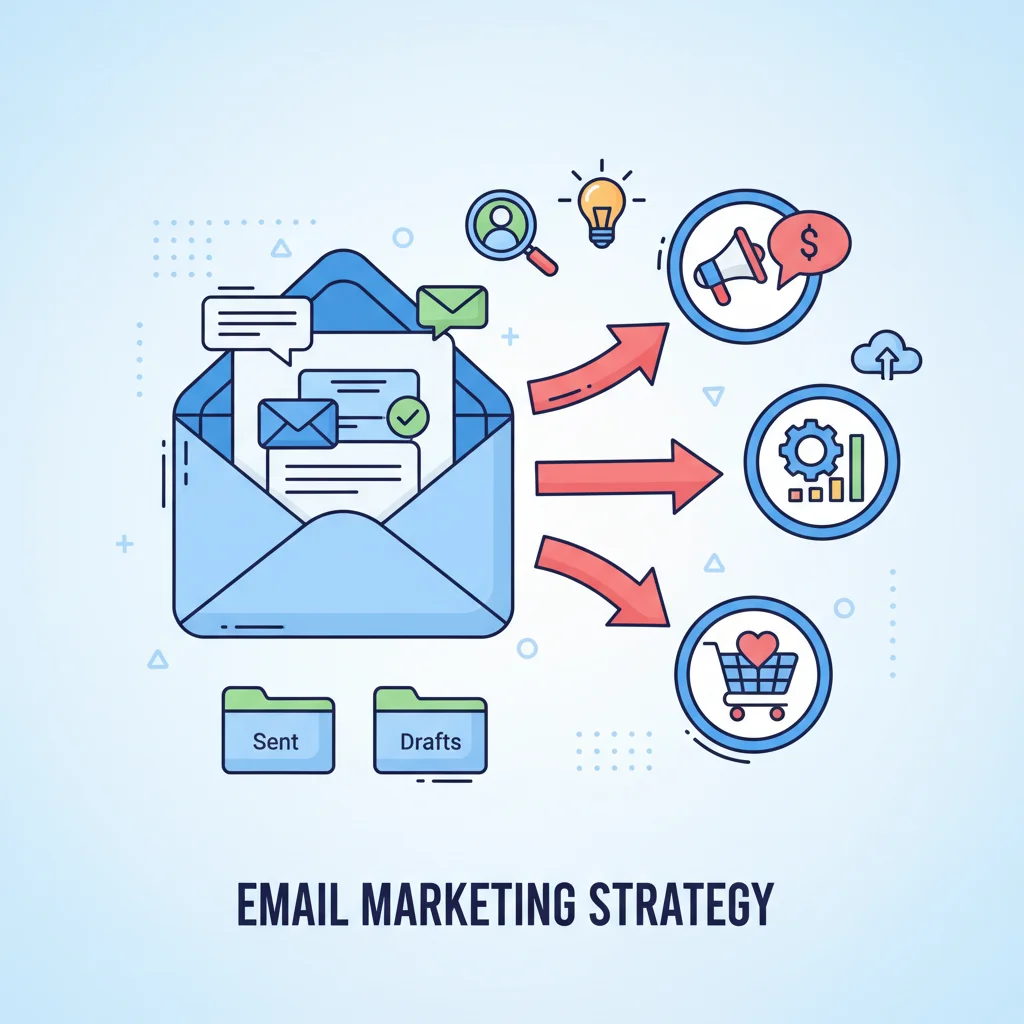Now Reading: Plain Text vs HTML: Best Email Format for Higher Deliverability
-
01
Plain Text vs HTML: Best Email Format for Higher Deliverability
Plain Text vs HTML: Best Email Format for Higher Deliverability

Are your emails actually reaching people’s inboxes? If you’re not sure, you might be overlooking one of the most fundamental aspects of email marketing: format choice. Should you use plain text or HTML for better deliverability? It’s a question that confuses even experienced marketers, but the answer can significantly impact your results. Let’s dive into the best email format for higher deliverability so you can make informed decisions that get your messages seen.
Key Takeaways
- Both plain text and HTML formats have their place, but plain text generally has higher deliverability rates (95-99% vs 88-95% for HTML)
- Plain text emails are lightweight, load instantly, work on all devices, and rarely trigger spam filters
- HTML emails offer better tracking, visual appeal, and brand consistency but come with deliverability risks
- The ideal approach is a hybrid: HTML emails with proper coding and a good text-to-image ratio, plus always including a plain text version
- Your audience and goals should determine your choice-test both formats with your specific subscribers
Plain Text vs HTML: The Great Email Format Debate
Let’s settle this once and for all. When it comes to the best email format for higher deliverability, there’s a constant tug-of-war between plain text and HTML. Both have their fans, both have their uses, and both have their problems.
What Exactly Is Plain Text Email?
Plain text emails are exactly what they sound like-just text. No fancy formatting, no images, no buttons. Think of them as the email equivalent of a handwritten note. They’re simple, straightforward, and kinda boring to look at.
Here’s what makes plain text emails special:
- They’re super lightweight (usually under 10KB)
- They load instantly, even on slow connections
- They work perfectly on ANY device (even that ancient flip phone your uncle still uses)
- They rarely trigger spam filters
- They feel more personal and direct
But let’s be real-they’re not exactly exciting to look at. And you can’t track opens reliably without HTML elements.
What About HTML Emails?
HTML emails are the colorful, designed emails you get from most businesses. They can include images, buttons, columns, background colors, and all sorts of fancy stuff.
The pros of HTML emails include:
- Visual appeal (they can look really professional)
- Better tracking capabilities
- Brand consistency with your website and other materials
- Ability to include buttons and calls-to-action that stand out
- Structure that guides the reader’s eye
But HTML comes with baggage:
- Higher chance of triggering spam filters
- Potential rendering issues across different email clients
- Slower loading times
- Higher likelihood of being clipped by Gmail and other providers
The Hard Data on Deliverability Rates
I’ve dug through mountains of research to find you some actual numbers. According to multiple email service providers:
- Plain text emails typically have deliverability rates between 95-99%
- HTML emails average between 88-95% deliverability
That difference might seem small, but when you’re sending thousands of emails, even a 5% improvement means hundreds more people seeing your message.
Why Plain Text Often Wins the Deliverability Game
There are several technical reasons why plain text emails tend to reach inboxes more reliably:
- Spam filter friendliness: Plain text emails contain fewer elements that trigger spam filters. No code to hide malicious content in, no suspicious image hosting domains, no embedded trackers that look sketchy.
- Size matters: Plain text emails are tiny in file size. Email servers love processing small files, and there’s less chance of timeouts or processing errors.
- Rendering consistency: There’s nothing to “render” in plain text-what you write is what appears. No chance of broken layouts making your email look unprofessional or suspicious.
- Authentication simplicity: Plain text emails are easier for authentication protocols like DKIM and SPF to verify, as there are fewer elements that could potentially be manipulated.
- Mobile-friendliness: Plain text automatically adapts to any screen size without complex responsive design requirements.
One email deliverability expert I follow puts it bluntly: “If your only goal is to reach the inbox, plain text is your safest bet.”
Useful Articles:
When HTML Is Actually Better for Deliverability
Despite plain text’s advantages, there are situations where HTML emails might actually perform better:
Subscriber Expectations Matter
If your audience expects visual content from you, sending plain text might actually hurt you. When subscribers receive an email format that doesn’t match their expectations, they might:
- Not recognize your brand
- Think something’s wrong with your company
- Mark the email as suspicious or spam
I’ve seen this happen with fashion and design brands. Their subscribers EXPECT beautiful imagery-when they suddenly got plain text emails, spam complaints actually increased!
Engagement Impacts Deliverability
Here’s something crucial that many people miss: deliverability isn’t just about reaching the inbox once. It’s about consistently reaching the inbox over time.
Modern email providers like Gmail track how users interact with your emails. If your HTML emails generate better engagement (more opens, clicks, and positive actions), this positive engagement history can actually improve your long-term deliverability.
So while your first plain text email might reach more inboxes, if your HTML emails generate more engagement, they might perform better over time.
Industry and Purpose Considerations
Your industry and email purpose should influence your format choice:
- B2B communications often perform better with simpler formats
- E-commerce typically needs HTML for showcasing products
- Transactional emails (receipts, confirmations) benefit from some HTML structure
- Newsletters with multiple topics work better with HTML organization
The Hybrid Approach: Best of Both Worlds
After testing hundreds of email campaigns, I’ve found that the highest deliverability comes from a thoughtful hybrid approach:
Always Include a Plain Text Version
This is non-negotiable! Even when sending HTML emails, always create a proper plain text alternative. Most email service providers make this easy.
Why? Because:
- Some email clients default to plain text
- Some users prefer plain text
- Spam filters check for plain text versions (emails without them look suspicious)
- Screen readers for visually impaired users often work better with plain text
Create HTML Emails That Act Like Plain Text
The smartest approach is creating HTML emails that capture the deliverability benefits of plain text while maintaining some visual advantages:
- Keep your HTML clean and simple
- Aim for a text-to-image ratio of at least 80:20 (80% text, 20% images)
- Avoid excessive use of div tags and complex table structures
- Don’t hide text in images
- Use web-safe fonts
- Keep file size under 100KB when possible
Code Quality Matters Enormously
Bad HTML code is a deliverability killer. Common issues include:
- Sloppy code copied from Word or other programs
- Excessive inline CSS
- Broken tags
- Missing alt text for images
- JavaScript (almost always a bad idea in email)
If you’re not comfortable coding HTML emails from scratch, use a reputable template from your email service provider.
Useful Articles:
Technical Factors That Impact Email Deliverability
Beyond just format choice, several technical elements affect whether your emails reach the inbox:
Authentication Protocols
Implementing these properly is crucial for deliverability:
- SPF (Sender Policy Framework): Verifies that your email is being sent from an authorized server
- DKIM (DomainKeys Identified Mail): Adds a digital signature to verify the email wasn’t altered in transit
- DMARC (Domain-based Message Authentication): Tells receiving servers what to do if SPF or DKIM checks fail
These work with both plain text and HTML, but HTML emails with authentication issues are more likely to be flagged as spam.
Domain Reputation
Your sending domain’s reputation affects deliverability more than format choice. A good domain reputation comes from:
- Consistent sending volume (no sudden spikes)
- Low bounce rates (under 2%)
- Low spam complaint rates (under 0.1%)
- Positive engagement metrics
IP Reputation
If you’re sending from a dedicated IP address, its reputation matters too. Shared IPs (common with email service providers) can be affected by other senders’ behaviors.
Format-Specific Optimization Tips
For Plain Text Emails:
- Use clear, descriptive subject lines
- Keep paragraphs short (3-4 lines max)
- Use asterisks for emphasis or ALL CAPS sparingly
- Create visual separation with line breaks
- Use URL shorteners for cleaner links
- Include a clear unsubscribe option
For HTML Emails:
- Design for the preview pane (top 300-500 pixels)
- Keep width under 600-650 pixels
- Use alt text for all images
- Ensure your email makes sense even with images disabled
- Test across multiple email clients
- Avoid background images in critical areas
- Use bulletproof buttons instead of image buttons
Useful Articles:
Making the Right Choice for Your Audience
The best email format depends largely on your specific audience. Here’s how to decide:
Know Your Audience Demographics
Different demographics have different preferences:
- Older audiences often prefer simpler formats with larger text
- Tech-savvy audiences usually have no issues with HTML
- Mobile-heavy audiences benefit from responsive HTML or simpler designs
- International audiences might have varying internet speeds and device types
Consider Your Industry
Some industries have established format expectations:
- Financial services and legal: Often more formal, with plain text or minimal HTML
- Retail and fashion: Usually image-heavy HTML
- B2B technology: Clean, professional HTML with moderate formatting
- Healthcare: Simple, accessible formats with clear information hierarchy
Test, Test, Test!
Don’t just take my word for it-test with YOUR audience:
- A/B test formats: Send the same content in different formats to segments of your list
- Track beyond opens: Look at clicks, conversions, and unsubscribes
- Survey your subscribers: Sometimes just asking format preferences works best
- Check your spam placement: Use seed list testing to see where your emails land
Email Client Considerations
Different email clients handle HTML differently, which affects deliverability:
Desktop Clients
- Outlook: Notorious for poor HTML rendering, especially with CSS
- Apple Mail: Generally good HTML support
- Thunderbird: Good HTML support with some quirks
Mobile Clients
- iOS Mail: Excellent HTML support
- Gmail app: Good support but clips messages over 102KB
- Outlook mobile: Better than desktop but still problematic
Webmail Providers
- Gmail: Strips some CSS and clips long messages
- Yahoo: Generally good HTML support but aggressive spam filtering
- Outlook.com: Better than desktop Outlook but still strips some CSS
Common Deliverability Killers (Regardless of Format)
Avoid these regardless of whether you use plain text or HTML:
- Spammy subject lines with excessive punctuation or ALL CAPS
- Misleading from names that hide who you really are
- Purchased email lists (just don’t!)
- Excessive exclamation points and spam trigger words
- Attachments (use links instead)
- URL shorteners in critical communications
- Sending from free email domains like Gmail or Yahoo
The Verdict: What’s Actually Best?
After all this analysis, what’s the best email format for higher deliverability?
The honest answer: it depends on your specific situation.
But if you want a practical, one-size-fits-most solution:
Use simple, clean HTML with proper coding standards, a good text-to-image ratio, and always include a well-formatted plain text version.
This approach gives you:
- The visual benefits of HTML
- The deliverability advantages of simpler formats
- Flexibility for different email clients and user preferences
- Better tracking capabilities than plain text alone
And remember – the best email format is the one that your specific audience engages with. A beautifully delivered email that nobody opens or clicks is still a failure.
I’ve found that testing different formats with small segments of your list before full sends is the most reliable way to determine what works for YOUR unique situation.
Ultimately, getting to the inbox is just the first step-what you do once you’re there is what really counts. So choose the format that best supports your message and drives action from your readers. Sometimes that’s plain text, sometimes it’s HTML, and often it’s somewhere in between.
The best email format for higher deliverability isn’t about choosing sides in the plain text vs. HTML debate-it’s about finding the sweet spot that works for your specific audience, industry, and goals. Test different approaches, monitor your results, and adjust accordingly. Your inbox placement rates will thank you!





















